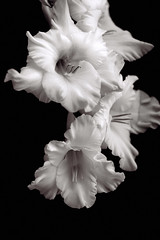Sometimes simplicity is tough but it's always worth it.
These are dry Holly and Salal leaves that have fallen from their plants and have weathered through the spring and summer. Both Holly and Salal are evergreen plants in the Pacific Northwest and the leaves are tough, thick and waxy. As they deteriorate, they dry out and lose their Chlorophyll, always curling up in some way. As they decay, each leaf is attacked by various bacteria, fungi and mechanical processes that cause them to develop new textures, holes, bumps, abrasions and missing chunks of various sorts and sizes.
In the process of its individual deterioration each leaf develops, to my eyes, an amazing amount of character. I find that close examination of each leaf is liking looking at the collection of laugh lines, freckles, and scars in a person's weathered face. I find myself profoundly fascinated by these decaying leaves, and I come back again and again to collect and photograph them.
The leaves (which seem to take on some individual animate qualities after awhile) are patient and allow me to arrange and rearrange them endlessly until some spatial variation strikes an inner chord. The dessication of their former leather-like toughness gives them a unique preservation of texture and sometimes a metallic color range as they fade and age. All in all, they make for nearly perfect subjects for black and white composition studies as well as for experiments in black and white conversion, toning and printing.
This set of leaves were collected and photographed on 11 August 2008 from a vast collection currently lying around the gardens near my home.
The processing for this image has a number of features that commend a short discussion, most notably that the final photo is a 2 image JPEG composite combined using Photoshop HDR methods to gently expand the dynamic range. This image confirms a notion I've had recently that a few, closely spaced bracketing exposures can go a good way towards expanding the dynamic range of an image without all the usual garish hallmarks of an HDR image.
After making a composite image, the usual cropping, levels and curves processing steps were done followed by a conversion to black and white using the CS3 black and white adjustment layer tool. I have been experimenting with this technique some and comparing it with other methods for B&W conversion with increasing satisfaction. I don't quite feel like I have it completely under control yet but I'm getting there I think.
After the B&W conversion, the image was given another round of levels and curves to normalize the new tonal range. Next, color tones were applied. After looking at some silver gelatin prints at a recent art show I decided to return to this set of colors again with more care. The tones on this image wound up as a combination of silver gelatin, platinum, and selenium. I think the combination came off very well and I am quire satisfied with it overall.
Next, a burning and dodging layer and a final sharpening ended the image processing with a final conversion to 72dpi and JPEG format.
I'm fairly pleased with this image and feel like it represents a leap in my compostion, in-camera visualization and my B&W processing skills. If and when I return to this image, I'd like to boost the range and contrast in the mid-tones a bit and experiment to see if compositing RAW images (as opposed to the JPEGs used here) returns significantly improved results or if the HDR process undid the JPEG color compression sufficiently that a RAW composite is not visually differentiable.
As always, comments and criticisms are welcome (does anyone actually read this blog?) either here on on flickr. Of course signed prints are for sale as well.
Subscribe to:
Posts (Atom)


